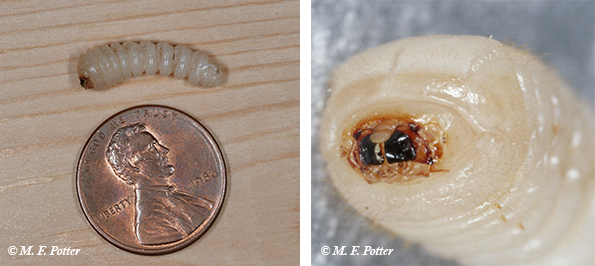Old House Borer
ENTFACT-653: Old House Borer | Download PDF
By Michael F. Potter, Extension Entomologist
The old house borer, Hylotrupes bajulus, isn’t as common as termites, but can cause extensive damage to structural wood. The pest is native to North Africa, but is prevalent throughout much of the world. Infestations in the U.S. are especially common in the eastern half of the country, particularly along the Atlantic Seaboard. Aided by shipment of infested logs and lumber, incidents occur elsewhere as well. Property owners often receive conflicting information about this pest, as they do with powderpost beetles (see University of Kentucky publication: Powderpost Beetles). This can lead to mistakes in diagnosing infestations, determining whether they are active, and deciding what should be done. This publication will help such determinations.
Description and Habits
Correct diagnosis of the old house borer is important since there are many other species associated with firewood, etc. that are less destructive. Definitive diagnosis may require confirmation by an entomologist or pest management professional. The adults are 5/8 to 1 inch long brownish to black beetles. The antennae are about 1/3 the length of the body, and there are two elevated black, shiny ‘knobs’ on the section behind the head. Faint patches of gray may also be present further back on the body. Finding an adult beetle is relatively rare; a few are occasionally found near windows or other light sources. The developing larvae remain hidden within the wood; if extracted, they can be identified by the presence of three tiny black eyespots (ocelli) in a row on either side of the head (other less destructive species have no more than one eyespot). A hand lens or microscope is necessary to see this feature.

While size of the adults can vary, the two shiny, raised black spots behind the head are distinctive.

Mature larvae are about an inch long and have three tiny dark eyespots in a row on either side of the head (circled in the detail below).
The black structures are the mandibles for chewing through wood.
As its name implies, the old house borer is able to infest the wood of older buildings. Nonetheless, the beetle prefers the protein-rich sapwood of younger wood. The heartwood portion of the wood is less desirable and protein within the sapwood declines as wood ages. Consequently, infestations are most common in structures less than about 10 years old. Old house borers only infest softwoods (needle-bearing conifers) such as pine, fir, and spruce— they will not attack hardwoods such as oak, ash, maple or poplar. Consequently, infestations within buildings are usually associated with structural components (studs, joists, beams, etc.) rather than manufactured items such as furniture or flooring. The beetles also are important pests of log homes, which often sustain more serious damage than conventional frame construction.
In the U.S., the old house borer is solely a pest of buildings and lumber; it does not infest living trees, stumps, or firewood. Infestations usually begin from lumber that had larvae prior to construction, originating where the wood was milled, processed or stored, or at the construction site.
Female beetles lay their eggs (about 50- 200) in cracks, crevices, and joints between wood members. The eggs hatch in a few weeks and the tiny larvae bore into the wood to feed. The grub-like larvae grow slowly, inflicting progressively more damage as they tunnel within the wood. Feeding and damage tend to be greatest closer to the surface where the protein content of the sapwood is highest. The average development time for the old house borer is about 3 to 6 years. Under optimal conditions, larvae may mature in as little as 2 years. In cooler locales, or if conditions within the wood are less favorable, development can be prolonged 10 years or longer. Moisture has an important effect on this— at higher wood moisture contents (15-25 percent), maturation of larvae is optimal; at wood moisture levels below 10 percent, the larvae are unlikely to survive. Fully mature larvae are stout (about the thickness of a pencil) and roughly an inch long. At this point, they tunnel to the surface, cut an oval-shaped emergence hole, and temporarily plug the hole with bits of wood. Some weeks later, the insect completes its development and emerges as an adult beetle.
Old house borers emerge from infested wood during spring and summer, most often June to August. Although the beetles are strong fliers capable of dispersing, they often attempt to reinfest wood members close to where they emerged.
Signs of Infestation
The most notable signs of an old house borer infestation are the oval, 1/4 to 3/8 inch holes made by the emerging adults. Other types of beetles make similar holes in wood, but the damage is usually insignificant. The most likely areas to find evidence of infestation is in attics, crawl spaces, unfinished basements, etc. where vulnerable wood is less obscured by finished walls, floors and ceilings. The emergence holes sometimes have ragged edges and can be harder to see on darkened surfaces. Holes in exterior siding, fascia boards, etc. also may be hard to spot, especially if they were sealed and painted over by previous owners.
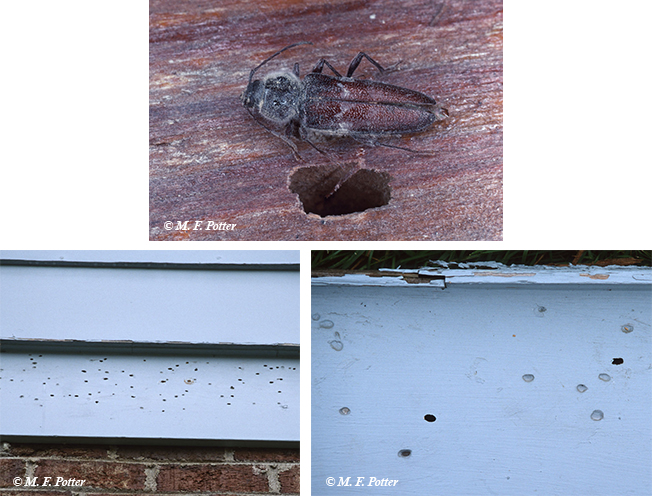
Old house borer emergence holes. Some of the holes in the exterior siding have been sealed and painted over.
Although old house borers can reinfest wood from one generation to the next, infestations also may die off if conditions are unfavorable. One indication of recent beetle activity is powder the color of freshly sawn wood sifting from exit holes, which often accumulates in small piles nearby. The powder (frass) is expelled from feeding galleries by the larvae and emerging adults. If powder is absent, or covered with cobwebs, dust or debris, there is a good chance the infestation has ceased. Long-abandoned beetle holes also tend to have the aged appearance of the surrounding wood. Probing suspected wood with a screwdriver can reveal internal damage and sometimes the larvae. The feeding galleries are filled with loose frass composed of fine particles and tiny barrel-shaped pellets of digested wood. Besides powder, feeding galleries of the old house borer have distinctive markings. The surfaces of most tunnels have a rippled appearance like when water washes over beach sand. Another telltale sign of an active infestation is the sound of larvae feeding within wood. The sound is produced by the rasping/ scraping action of the insect’s mandibles. The intermittent gnawing sounds are especially noticeable once larvae are fully-grown, and often can be heard through walls, floors and ceilings.

Fresh powder sifting from recent emergence holes. Damage may be evident just below the wood surface.

Larval tunnels are filled with powder and often display a rippled appearance.
Destructive Potential
Damage caused by this pest varies from building to building. Climate-controlled, well-ventilated structures with no moisture problems usually sustain minimal damage since reinfestation beyond the first generation of beetles is unlikely. In such cases, only a few boards may be damaged. Conversely, serious damage can occur over time in damp, poorly ventilated crawlspaces, basements, attics, or outbuildings. Studs, joists, and other wood components can be reduced to powder with only a thin outer layer of wood left intact. Where infestations have perpetuated for many years, structural collapse can occur. At times, larvae also will bore through wallboard, plaster, and exterior trim and siding from underlying wood members. Location and pattern of the exit holes can help determine which nearby framing members are involved.

Significant damage can occur in humid, poorly ventilated crawlspaces and attics.
Old house borers are a particular problem in log homes. Logs can become infested when the timbers were initially processed, or during/after construction. Relative to frame construction, the exterior of log houses may be more vulnerable to moisture problems and potential infestation. Beetle holes in the exterior surface of the logs can also permit water to enter and cause additional problems from decay.
Prevention and Management
There are different options for managing old house borers. Choosing the best approach depends on factors like the degree of damage, likelihood of re-infestation, and effort/expense. As with other wood-infesting pests, old house borers damage wood slowly. There is no need to act immediately for fear of risking the structural integrity of one’s home. A conservative, science-based approach makes the most sense, especially when there is uncertainty whether the infestation is still active.
Prevention – Old house borers typically enter buildings in infested lumber. Since the beetles only attack pine and other softwoods, materials such as hardwood flooring, cabinetry, and furniture are generally immune. Infestations usually originate where wood is processed and stored, or at the construction site. The most vulnerable time for exposed lumber to become infested is when adult beetles are emerging and laying eggs, especially June through August.
Before wood is used for construction, most of the water is removed by air-drying or kiln drying. Kiln-dried lumber is heated for a period of hours to a temperature of about 125-140°F. This is sufficient to kill all beetles that might be in the wood prior to heating. However, even wood that is properly kiln dried can become infested during subsequent transit and storage. The longer wood sits in a vulnerable condition, the greater the chance beetles will find and lay eggs on the lumber.
Wood that is suspected of harboring beetles should not be used, especially if emergence holes or powder is present. Some of the most serious infestations occur from using repurposed lumber from a barn, etc. to panel a room or build an addition.
Wood Replacement- Oftentimes, indications of beetle activity are limited to only a few boards or sections of wood. The most efficient approach is to remove and replace them. As an added precaution, it also may be prudent to replace those adjacent to any that are damaged since larval tunneling sometimes extends from one piece to the next. Beetle holes in wood that was not replaced should be sealed and all visible wood powder removed so that old damage will not be mistaken for new.
Moisture Control- Old house borers have high moisture needs for survival. Anything that reduces the moisture content of wood to suboptimal levels (ideally below about 10 percent) will slow development and break the cycle of reinfestaton. It is advisable to lower dampness and humidity in crawlspaces, basements, attics, etc. by installing a vapor barrier, increasing ventilation/air circulation, and improving drainage. Moisture meters utilized by pest control firms are handy tools for measuring the moisture content of wood and predicting the potential for continued infestation.
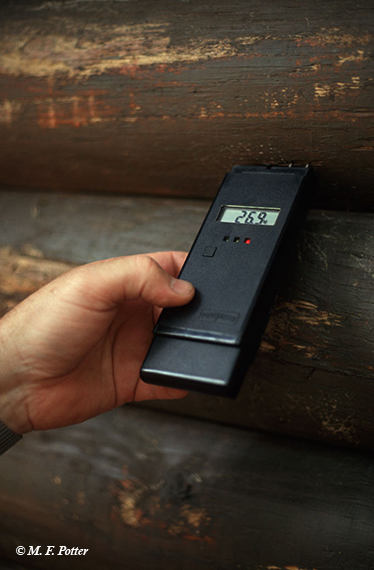
Moisture meters are useful tools for predicting potential for reinfestation.
Lethal Temperatures- As previously mentioned heating lumber to 125-140°F for several hours in a kiln is sufficient to kill all stages of the beetle. Although the pest control industry uses heat to control bed bugs, it would be far harder to achieve lethal temperatures in studs, joists, and other structural components where the beetles reside. Other species (e.g., powderpost beetles) infesting items such as woodcarvings and picture frames can be killed with such methods, or by holding them several days in a deep freeze (For more on this topic, see University of Kentucky Entomology Entfact-640, Thermal Deinfestation of Household Items.)
Residual Insecticides- Various insecticides are labeled to treat beetle-infested wood. Insecticides known as borates (e.g., Bora-Care, Tim-bor) are most widely used for this purpose. Borate sprays have the potential to penetrate and kill beetles within wood, especially when they enter or exit the wood surface. Depth of penetration will depend on the wood’s moisture content; the damper the wood, the deeper they generally penetrate. At lower moisture levels (e.g., 10-15%), effective concentrations of borate penetrate only about 1/8 to 1/4 inch — still sufficient to kill newly hatched larvae before they tunnel more deeply, thus breaking the cycle of reinfestation. Wood surfaces must be unfinished since the spray will not penetrate water-repellent coatings. For this reason, borate insecticides are most suited for treating joists, beams, and other structural components. In the case of log homes, older water-repellent coatings can be somewhat diminished by pressure washing.
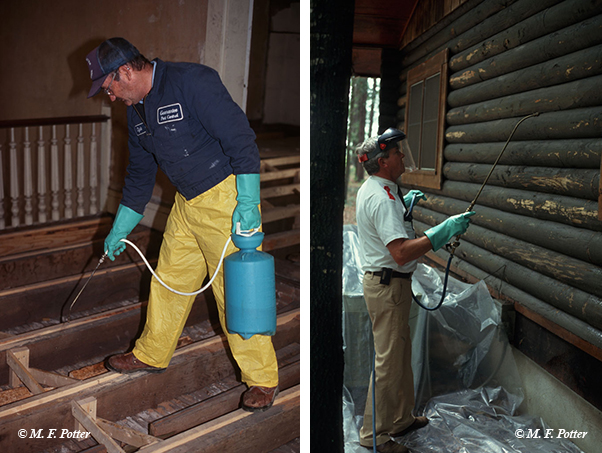
Borate sprays are well suited for treating infested or vulnerable wood.
If limited areas are affected, insecticides formulated as liquids, aerosols or dusts can be injected directly into infested wood. To accomplish this, holes are drilled through the edge or facing of the wood to contact as many feeding galleries as possible.
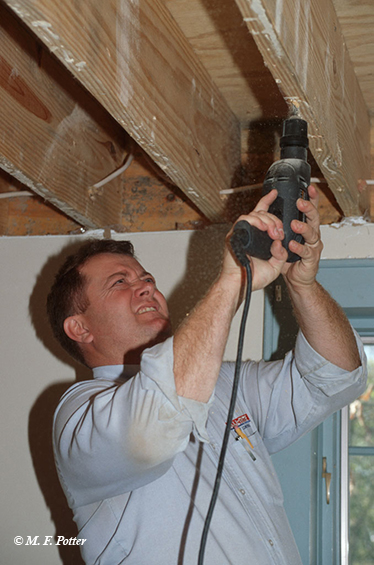
Insecticides can also be applied by drilling and injecting directly into infested wood.
Fumigation- Fumigation is an extreme and costly option for ridding a building of old house borers. Homes undergoing fumigation are sealed with tarps and occupants must remain out for a few days. The concentration of gas is monitored/maintained at a specified level, and before being reoccupied, the building is ventilated.
Current fumigants containing sulfuryl fluoride (e.g., Vikane) are less effective on wood-boring beetles than former compounds containing methyl bromide, which is no longer available. Consequently, de-infestation may not be successful. Structural fumigation may be warranted when infestations have spread into walls, between floors, and other areas where access for surface treatment or wood removal is impractical. The best way to avoid such problems is early detection and employment of other corrective measures. Portable wood material such as a stack of lumber can be fumigated more efficiently and economically under tarps or in trailers. Some pest control firms offer this service to clients.
In Summary
Old house borer infestations can be confusing and stressful. It is important to diagnose the problem correctly to avoid unneeded effort and expense. Identifying the beetle involved and whether the infestation is active are important first steps. Other considerations include the extent of infestation and type, age, and moisture content of the wood. Since beetle damage progresses slowly, take time to consider the options available for remediation. Extremes such as fumigating the building are seldom necessary.
Customers sometimes have concerns that old house borers will harm the future resale value of their home. Since infestations seldom persist for long periods of time, this should not be a big concern. Many more homes have been treated for termites and have retained their market value, and these beetles are even less threatening.
CAUTION! Pesticide recommendations in this publication are registered for use in Kentucky, USA ONLY! The use of some products may not be legal in your state or country. Please check with your local county agent or regulatory official before using any pesticide mentioned in this publication.
Of course, ALWAYS READ AND FOLLOW LABEL DIRECTIONS FOR SAFE USE OF ANY PESTICIDE!
Photos: © M. Potter, University of Kentucky Entomology
